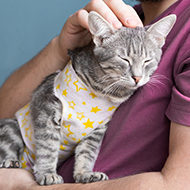New cat population model shows impact of neutering
"Our study shows that connectivity between cat subpopulations can have a big influence on population dynamics" – Jenni McDonald.
Researchers at Cats Protection have created a new model to study the effect that different neutering scenarios could have on the UK cat population.
The model is the first to take into account the different subpopulations of UK cats – owned, stray, feral, and shelter cats – and how they are linked through breeding and cats transitioning between the categories.
Using the model, the researchers were able to test how different neutering scenarios for female cats would impact each subpopulation. They ran a variety of scenarios, each projecting 10 years into the future.
The model revealed that the level of neutering in the owned cat population had the biggest impact on overall population dynamics. Neutering owned cats at a younger age was enough to reduce overall population growth, regardless of neutering rates in the other subpopulations.
Researchers at the charity plan to continue using the model, refining it as more data about UK cat populations becomes available. Current information about feral and stray cat populations is comparatively sparse.
An estimated 250,000 unowned cats live in towns and cities in the UK and around 300,000 feral cats live on farms, in addition to more than 150,000 cats in shelters. Most recent estimates suggest there are more than 10 million owned cats in the UK, the majority of which are neutered.
Dr Jenni McDonald, lead researcher on the study, said: “We previously had little robust understanding of just how important the links between cat subpopulations are. Our study shows that connectivity between cat subpopulations can have a big influence on population dynamics.
“However, this is just the beginning we’re excited to now have a model framework that we can continually refine and update going forward in support of the charity’s work to ensure the UK cat population is balanced so that every cat has their best possible life.”
Cats Protection’s director of feline welfare Dr Maggie Roberts added: “The current findings highlight not only the important effect neutering owned cats has on all cat populations, but also how the timing of neutering in itself is key to population management.
“It’s a stark reminder during this cost-of-living crisis of the importance of the prioritisation of timely neutering to prevent a growth in population that cannot be adequately supported.”
The study, ‘Cat: Empirical modelling of Felis catus population dynamics in the UK’, has been published in the journal Plos One.



 RCVS Knowledge has called on vet practices to audit their post-operative neutering outcomes.
RCVS Knowledge has called on vet practices to audit their post-operative neutering outcomes.